When a reservoir conduit cannot be closed, thousands of cubic feet of water can roar through uncontrolled, threatening public safety, irreplaceable reservoir storage, and power generation. Seal Team Fix invites engineers, fabricators, and creative problem-solvers to stop that torrent in its tracks. Your mission: design a rapid-deploying, temporary seal that can be deployed to a submerged 3- to 25-ft diameter conduit opening, accommodate differential pressure, and achieve a 95–98 % flow reduction - without leaning on trash racks or other non-structural surfaces.
The competition unfolds in three phases: a short-format concept white paper, a funded prototype build, and a lab-scale hydraulic demonstration. Up to $575,000 in prizes is on the line, along with the chance to safeguard water and power for millions across the American West. Ready to tackle one of Reclamation’s toughest infrastructure challenges? Follow this challenge, explore the full guidelines, and join the team that makes the best sealing solution a reality.
Welcome to the front line of dam-safety innovation. By opening these guidelines you’ve already accepted the call to tame torrents that can tear through massive conduits when gates fail. Read on to learn the hydropower realities, the engineering constraints, and the breakthrough we need you to deliver.
For over a century, the Bureau of Reclamation (Reclamation) has played a foundational role in shaping the infrastructure of the American West. As the nation’s largest wholesale water supplier, Reclamation manages more than 330 reservoirs that collectively store over 140 million acre-feet of water – delivering this critical resource to support agriculture, energy generation, ecosystems, and growing communities across 17 western states.
At the heart of many Reclamation facilities – hydroelectric powerplants, pumping stations, and water delivery systems – are large conduits. These massive, engineered passages are essential for routing water through complex systems of dams and reservoirs. Maintaining structural integrity and operational control of flow through conduits is not only fundamental to ensuring steady water and power delivery, but also to protect public safety and avoid potentially devastating losses of water and economic productivity.
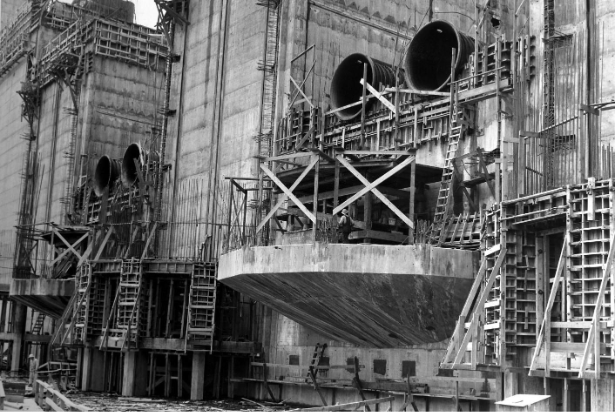
Image 1. Conduit pipes built into Shasta Dam in 1944 during dam construction and prior to filling the reservoir with water - https://www.flickr.com/photos/usbr/51146806068/in/album-72157718499009604/.
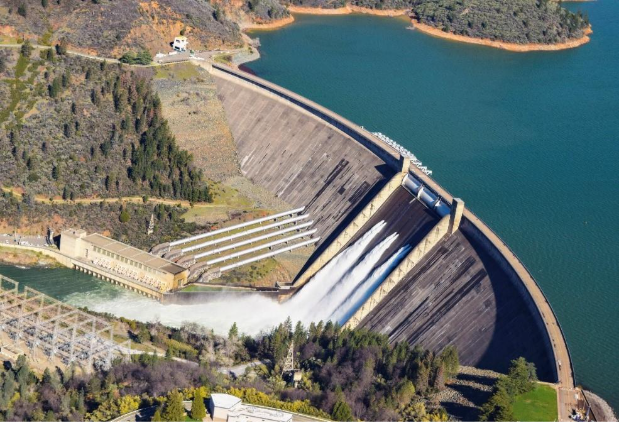
Image 2. Shasta Dam after completion with dam outlet works releasing water at the center of the photo. The photo also shows above ground penstocks to the top-left of the dam outlet works that are also a conduit with an inlet at the upstream reservoir.
A point of clarification: the term “conduit” in this context refers to the interior passage itself. The “inlet” is the conduit entrance – typically where water first meets a trash rack structure and a control gate. Conduits and their inlets vary significantly across Reclamation facilities. In most cases, the conduit itself is circular in cross-section and typically lined with concrete or steel. However, the inlet, where water first enters the system and where a sealing solution is most likely to be deployed, may be rectangular and transition to circular, especially near gates or valves, and is likely to be a mix of concrete and steel. Please see the glossary of challenge terms on the Resources tab for more information.
Because of various factors (e.g., gates may be partially closed when they fail, existing trash racks and gates present access impediments, each facility is unique, etc.), the geometry and condition of the mating surface can be irregular or unpredictable. As a result, sealing solutions designed to address uncontrolled flow must account for the range of geometries and be flexible and adaptable to varying and potentially non-uniform mating surfaces, etc.

Image 3. Example conduit transition shown; image is the downstream conduit outlet at jet flow gate with bulkhead guides at left and right sides; no trash rack shown (not typical at conduit outlets)
Conduits are submerged dozens to hundreds of feet below a reservoir’s water surface and experience a wide range of environmental and operational conditions. Sealing solutions may be deployed from permanent structures such as dam crests or intake decks that are within a few hundred feet above the conduit, maximum. Intake towers are a common feature at the inlet. These towers are typically cylindrical vertical structures, located at or near the upstream face of the dam, with multiple submerged trash rack inlets positioned around their perimeter to protect a singular conduit inlet. Intake towers can pose unique geometric and access challenges, especially for conveyance and anchoring mechanisms. It is also important to note that approximately one-third of Reclamation dams are embankment dams, which commonly feature intake towers upstream of the embankment. In contrast to traditional concrete dams – which may present more accessible sealing surfaces – the sealing system may need to be lowered from a barge or from specialized equipment positioned near the tower, rather than from the dam crest. guidelines.
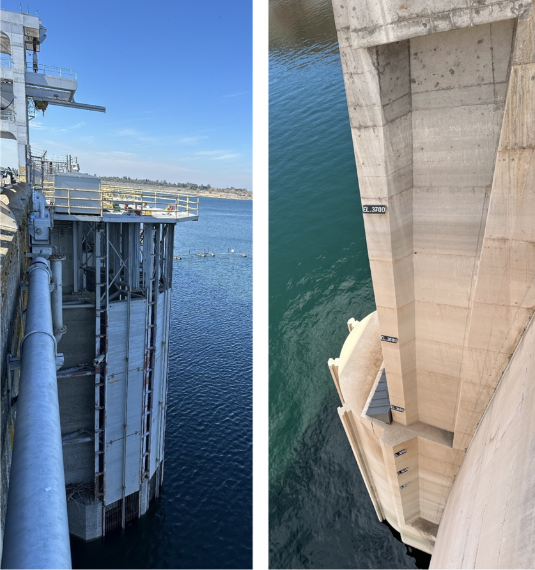
Image 4. Example concrete dams with available overhead crane and cylindrical vertical intake towers directly on the dam face; for both images, the towers are trash rack structures to protect the conduit inlet; a typical trash rack is visible at the water line in the left photo.
Because the sealing surface and surrounding geometry may vary significantly – and may not match original design drawings due to age, maintenance history, or structural changes – adaptability and design flexibility are critical. Challenge participants should avoid assuming uniform shapes or access conditions and instead consider how their solutions could perform in multiple deployment environments.
The challenge of controlling water flows from conduits, especially during emergency scenarios such as gate failure, is the focus of this prize competition.
Across Reclamation facilities, a significant vulnerability exists: the failure or inoperability of primary gates controlling flow through large water conveyance conduits. When these gates fail, whether due to mechanical malfunction, debris interference, or control system issues, uncontrolled water loss continues until the gate can be closed, or the conduit can somehow be sealed. This is not just an operational inconvenience. Rapid and reliable intervention becomes essential to prevent damage, protect downstream communities, conserve valuable water resources, and regain control of critical infrastructure.
These vulnerabilities are often tied to the age and configuration of the infrastructure itself. Many of the conduits in use today were constructed between the 1930s and 1960s. In some facilities, especially smaller or older ones, there is no redundant gate system or secondary method of flow control. As a result, even the failure of a “non-main” conduit can lead to a cascading emergency.
Gate failures are rare, but when they happen, they can happen fast. A single triggering event such as a landslide, seismic activity, or power outage can simultaneously affect multiple conduits, especially in facilities lacking redundancy. Solutions must therefore be capable of sealing conduits under a wide range of conditions, including temperature, significant debris loads, and head pressures concentrated at the inlet.
High-head conditions – defined for the purposes of this challenge as pressures up to 200 feet – present formidable hydraulic forces. (At some facilities head pressure can exceed 300 feet.) Combined with velocities that may reach or exceed 100 feet per second, these forces exceed the operating envelope of most commercially available sealing or closure technologies. That’s why Reclamation has not yet identified an off-the-shelf solution capable of addressing this problem effectively.
Complicating matters further is the harsh operational environment. Inlet access points may lie 20 to 350 feet below the water surface. Downstream access may be fully submerged and unreachable during a failure event. Existing structures, particularly trash racks, can obstruct or limit access to the inlet and the means of deployment and should not bear a solution’s load. In some cases, access for equipment or vehicles (such as cranes or underwater vehicles) above the water’s surface and inlet may be constrained by structural limits on dam crests (10-20 tons) or the specifications of existing hoisting infrastructure. While some dams may have standard mobile equipment available for deployment, others impose weight and space restrictions that must be carefully considered in the design of any sealing system.
The conduits and inlets themselves are diverse, as discussed previously. During a gate failure – or similar event resulting in uncontrolled flow through a conduit, the full hydraulic pressure of the reservoir bears down on the inlet of the conduit. Flow restrictions at the inlet, such as a partially closed gate, cause significantly lower pressure at the downstream side of the restriction due to unregulated outflow. As a sealing solution is introduced and begins to restrict flow, it must endure and adapt to this growing differential – with higher pressure on the upstream (reservoir) side and decreasing pressure on the downstream side. For this reason, proposed solutions should seal incrementally, allowing the system to gradually take on the increasing load rather than resisting full force immediately. Solvers should not assume static conditions during installation. Instead, they must account for a dynamic environment, where pressure conditions shift as the system moves into place and begins restricting flow.
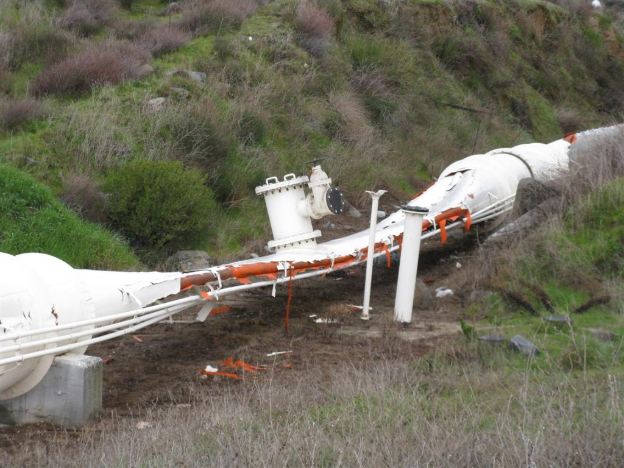 Image 5. Pipe collapse resulting from pressure differential; insufficient replacement air supplied through air vents during operation caused negative pressures inside the pipe and, ultimately, collapse.
Image 5. Pipe collapse resulting from pressure differential; insufficient replacement air supplied through air vents during operation caused negative pressures inside the pipe and, ultimately, collapse.
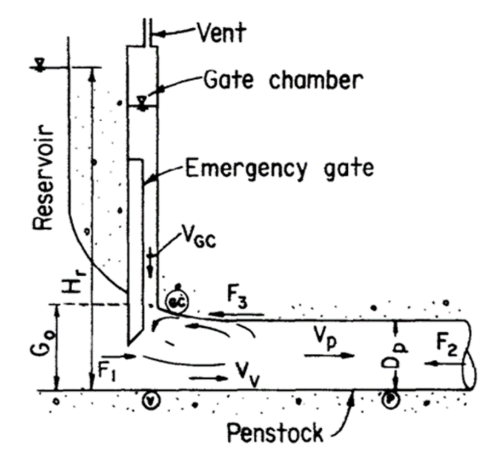
Image 6. Schematic of air vent for emergency gate closure; incremental conduit sealing assures proper air vent function to prevent negative pressure and possible pipe collapse.
The consequences of uncontrolled releases are severe. They range from significant water loss and downstream flooding to property damage and, in the most serious cases, risk to human life. With increasing strain on water systems and infrastructure aging across the region, the need for a rapid, effective sealing solution has never been more urgent.
Reclamation is seeking a fundamentally new approach to a decades-old problem: how to quickly and effectively seal large conduits experiencing uncontrolled, high-head flow due to gate failure. No existing commercial technology has proven capable of addressing the extreme conditions involved: velocities approaching 100 ft/s, pressures of up to 200 feet of head, constrained access, and the risk of catastrophic failure. A breakthrough solution is urgently needed.
At the heart of this challenge is a clearly defined operational goal: minimize the volume of uncontrolled water release following a gate failure. To be viable, a proposed sealing solution must achieve a seal effectiveness of at least 95–98%, meaning it must stop nearly all of the flow through the affected conduit. While real-world emergency validation is not part of this challenge, seal effectiveness will ultimately be assessed through controlled flow laboratory tests, in phase 3, by measuring water volume decrease over time.
Proposed concepts must meet the following critical requirements:
Rapid Deployment: The system must be able to be installed within 1–2 days from arrival onsite.
No Diver Intervention: Solutions that require divers for setup, alignment, or anchoring could be dangerous to personnel and should be avoided.
Safe and Reliable: Both the sealing mechanism and the deployment process must prioritize personnel safety, structural compatibility, and system reliability under emergency conditions.
High-Flow, High-Pressure Capable: Designs must demonstrate they can be incrementally installed and successfully restrict flow under velocities up to 100 ft/s and head pressures up to 200 ft.
Adaptable to Varied Geometry: Solutions should work across a range of conduit diameters – from 3 feet to 25 feet – and be compatible with variable cross-sections, material interfaces, and inlet shapes.
Temporary Duration: The seal is expected to hold for a window of several months, up to a year—long enough to allow upstream isolation or full repair of the failed gate.
Account for Pressure Differential: Designs must account for the pressure difference between upstream and downstream sides of the sealing solution, when installing, seating, anchoring, and reinforcing the sealing mechanism.
System Removal: The sealing system must be removable or allow for re-opening of the conduit after the emergency has passed.
Bearing of Structural Load: All reaction loads from your sealing device should bear on the conduit wall or the dam face itself. Clearly illustrate expected load paths and bearing pressures. Trash racks prevent debris from entering a conduit and are not designed to withstand differential pressure.
Solutions should also explicitly address the four core engineering functions defined by Reclamation:
Deployment – how the system, at the site, is positioned on the inlet, bearing its load independent of trash rack structures;
Obstructing Flow – how the system physically and incrementally stops or reduces flow;
Seal Performance – how the system remains sealed under pressure and for the required duration, and;
System Removal – how the system is withdrawn or deactivated without damaging the conduit or requiring extensive post-use intervention.
A successful concept will not only meet these performance goals but also clearly describe how it operates under real-world constraints. Reclamation is not interested in broad concepts that rely on ideal conditions—solutions must be grounded in practicality, deployability, and real engineering judgment.
Out of Scope:
Any solutions requiring manual diver-based installation
Solutions requiring permanent modifications to the conduit or inlet structure, unless the modification adds significant structural or operational value and is clearly justified.
Any concept that applies sealing loads directly to un-reinforced trash rack elements.
To solve the urgent problem of uncontrolled flow in high-head conduits, this challenge will unfold across three escalating phases: conceptual design, prototype development, and lab-based demonstration. Each phase is designed to progressively de-risk and mature potential solutions that can perform under the conditions outlined earlier.
Phase 1: Concept Design
Type: Theoretical
Deliverable: Concept White Paper
In Phase 1, participants are tasked with developing a conceptual sealing system and submitting a detailed white paper. This is a design-focused stage that requires more than just an idea: teams must provide clear, technically reasoned descriptions of their solution’s configuration, how it would be deployed and installed, and how it would perform under the severe hydraulic and access constraints typical of Reclamation conduit and inlet structures.
Submissions should include:
Conceptual schematics or illustrations
Description of materials or construction methods (as currently envisioned)
Estimated seal effectiveness and operational durability
Engineering calculations as appropriate to support the primary design principles
Explanation of how the concept addresses the four engineering functions:
Deployment, Obstructing Flow, Seal Performance, and System Removal
The primary objective of this phase is to identify viable and novel design approaches, and teams capable of further developing them. Up to 5 winners will be selected, each receiving a $50,000 prize award .
Phase 2: Prototype Development
Type: Proof-of-Concept
Deliverable: Working Prototype (scale TBA)
Phase 2 will focus on converting selected Phase 1 concepts into functional prototypes (estimated TRL 4-6). Teams will demonstrate constructability and begin addressing practical engineering constraints: deployment, mechanical forces, sealing surfaces, friction, turbulence, access tools, anchoring systems, etc.
The goal of this phase is to show that the proposed design is not just creative, but buildable, and that its functionality supports the primary design principles and can be reasonably validated through controlled testing. Up to 3 winners from Phase 2 will advance to lab testing with a Phase 2 total prize purse of up to $225,000. Prize structure and distributions to be released at a later date.
Phase 3: Demonstration and Testing
Type: Laboratory Validation
Deliverable: Demonstration in Hydraulic Lab Model
The final phase will take place in a Reclamation controlled laboratory setting using physical hydraulic models simulating the operating conditions of Reclamation conduits. Participants will ship their solutions to a designated laboratory for testing. This scaled model will have a conduit inlet size of approximately 12 inches with associated laboratory pressures and velocities. The exact constraints will be based on the final selected laboratory model geometry. Selected Phase 2 solutions will be tested to verify:
Functional deployment and retrieval
Incremental conduit seal (installation)
Stability under different pressure scenarios (pressure spikes)
Effectiveness of seal (target remains 95–98%)
This phase is designed to rigorously validate performance before any future field application. The most successful solution(s) will be those that demonstrate real-world potential and are positioned for further development or operational deployment by Reclamation.
Up to one Phase 3 winner will receive an award of up to $75,000. Innovation award(s) of up to $25,000 are also available.
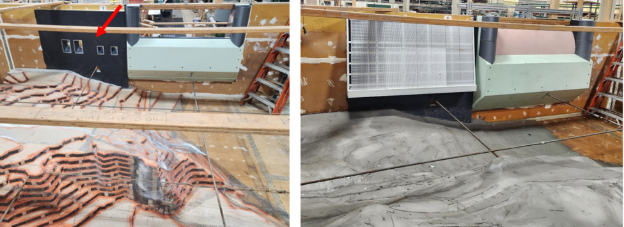
Image 7. Example hydraulic model of a concrete dam with four conduit inlets shown (see red arrow at left) and after installing a trash rack structure over the four conduit inlets (at right).
To be eligible for an award, your proposal must, at minimum:
Satisfy the Judging Criteria requirements.
Thoughtfully address the Submission Form questions.
Be scored higher than your competitors!
Phase 1 Submission: Concept White Paper
Challenge participants are invited to submit a concept white paper that presents a detailed and technically grounded conceptual design. This white paper is the foundation upon which Reclamation will evaluate each team's understanding of the problem, creativity in design, and feasibility of implementation. The white paper should describe a proposed apparatus and system capable of sealing a failed conduit under the extreme hydraulic conditions outlined earlier. The submission should demonstrate how the system is deployable and effective in an environment defined by high pressures, high flow velocities, submerged access, and the presence of structural constraints like trash racks.
Submissions should also describe expected flow reduction behavior during installation, and envision any critical inspections or checks required if the system is stored off-site. A strong submission will demonstrate an understanding of both best-case and failure-prone deployment scenarios.
While Reclamation may consider cost-effectiveness in later phases, Phase 1 judging will focus on the technical viability, design completeness, and novelty of the proposed concept. Participants are encouraged to present designs that are realistic, thoughtfully constrained, and demonstrate an understanding of the actual conditions in which such a system would need to function.
Details about the submission requirements and judging criteria for Phases 2 and 3 will be released at a later date.
PHASE 1 JUDGING CRITERIA
Criterion | Description | Weight |
1. Technical Feasibility | - How feasible is the submission’s explanation of how the system is conveyed and positioned on the inlet under high-flow / high-head conditions? - How effectively does the proposed deployment process allow for incremental installation to safely relieve differential pressure? - To what extent does the design show a technically sound method for reducing or stopping flow (including in high-head conditions)? - How appropriate are material choices and structural elements for the hydraulic forces involved? - How well does the concept demonstrate that it can maintain a 95–98 % seal for the required duration? - How clearly is the removal or deactivation process described, and is it feasible? | 40% |
2. Adaptability and Structural Compatibility | - How well does the design accommodate the range of conduit diameters (3 ft to 25 ft)? - How well does the solution demonstrate a clear load path and bearing pressures onto the conduit wall or dam face that avoids trash racks or provides verified reinforcement? | 25% |
3. Execution Path and Team Capability | - How well does the white paper demonstrate relevant technical understanding or experience (either through the team’s background or the maturity of the concept)? - How “ready” does the team seem to be able to execute on their plan as soon as Phase 2 begins? | 25% |
4. Innovation and Design Novelty | - How original is the proposed solution in terms of mechanical design, deployment strategy, or sealing concept? | 10% |
Phase | Number of Winners | Prize per Winner | Subtotal (Max) |
Phase 1: Concept Design | Up to 5 | $50,000 | $250,000 |
Phase 2: Prototype Development | Up to 3 advancing winners | Prize structure TBD* | Up to $225,000 |
Phase 3: Demonstration & Testing | 1 main winner + innovation award(s) | Main: up to $75,000 | Up to $100,000 |
Innovation: up to $25,000 | |||
|
| Total Maximum Prize Pool | $575,000 |
*The Phase 2 prize distribution will be announced later, but the total available is capped at $225,000 for up to 3 winning teams that advance to testing. | |||
Open to submissions (Phase 1) | July 22, 2025 9AM EDT |
Phase 1 Submission deadline | October 14, 2025 @ 5pm EDT |
Phase 1 Judging | October 15 to November 25, 2025 |
Phase 1 Winners Announced | December 16, 2025 |
Phase 2 (Prototyping) | December 2025 – April 2026 |
Phase 3 (Demonstration and Testing) | May/June - November 2026 |
Participation Eligibility:
Please review the Challenge-Specific Agreement for complete eligibility terms.
The Prize is open to anyone age 18 or older participating as an individual or as a team. Individual competitors and teams may originate from any country, as long as United States federal sanctions do not prohibit participation (see: https://www.treasury.gov/resource-center/sanctions/Programs/Pages/Programs.aspx).
If you are a Federal employee, a Government contractor, or employed by a Government Contractor, your participation in this challenge may be restricted or prohibited.
Submissions must originate from either the U.S. or a designated country (see definition of designated country at https://www.acquisition.gov/far/part-25#FAR_25_003), OR have been substantially transformed in the US or designated country prior to prototype delivery pursuant to FAR 25.403(c).
Submissions must be made in English. All challenge-related communication will be in English.
You are required to ensure that all releases or transfers of technical data to non-US persons comply with International Traffic in Arms Regulation (ITAR), 22 C.F.R. §§ 120.1 to 130.17.
No specific qualifications or expertise in the field of engineering is required. Individuals and non-expert teams are encouraged to compete and propose new solutions.
To be eligible to compete, you must comply with all the terms of the challenge as defined in the Challenge-Specific Agreement.
Intellectual Property
Innovators who are awarded a prize for their submission must agree to grant the United States Government a royalty-free, non-exclusive, irrevocable, worldwide license in all Intellectual Property demonstrated by the winning/awarded submissions. See the Challenge-Specific Agreement for complete details.
You will be required to complete an additional form to document this license if you are selected as a winner.
Registration and Submissions:
Submissions must be made online (only), via upload to the HeroX.com website by October 14th, 2025 at 5pm ET. No late submissions will be accepted.
Selection of Winners:
Based on the winning criteria, prizes will be awarded per the weighted Judging Criteria section above and subject matter expert evaluation. All winner selections are final and may not be contested.
Judging Panel:
The determination of the winners will be made by HeroX based on evaluation by a team of relevant subject matter experts.
Additional Information
By participating in the challenge, each competitor agrees to submit only their original idea. Any indication of "copying" amongst competitors is grounds for disqualification.
Innovator is responsible for shipping prototype in Phase 3. International participants are required to manage all requirements regarding US customs for Phase 3 shipping of solutions. Prototypes will not be returned.
All applications will go through a process of due diligence; any application found to be misrepresentative, plagiarized, or sharing an idea that is not their own will be automatically disqualified.
All ineligible applicants will be automatically removed from the competition with no recourse or reimbursement.
No purchase or payment of any kind is necessary to enter or win the competition.
Void wherever restricted or prohibited by law.